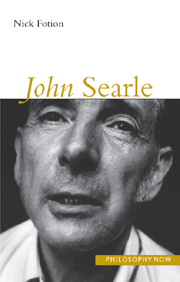1 - Searle's speech act theory
from Part I - Philosophy of language
Summary
Background
John Searle's first major work, Speech Acts, appeared in 1969. By then, the tradition of language analysis within which it was framed had matured. Indeed, it was already in the second stage of development.
The first stage was strongly influenced by the many accomplishments of science. By the end of the nineteenth century, the revolutionary notion of “natural selection” developed by Charles Darwin in his The Origins of the Species in 1859 and The Descent of Man in 1871 had taken hold. Soon after, in 1905, Albert Einstein presented his special theory of relativity to the world, followed by his general theory in 1916. About the same time, electrons and other subatomic particles were discovered, and Max Planck and Niels Bohr developed their versions of the atomic and quantum theories. Science was on the move. If the changes in science that Copernicus, Brahe, Kepler, Galileo, Newton, Harvey and others had brought about in earlier centuries were revolutionary, the more recent changes toward the end of the nineteenth century and the beginning of the twentieth were equally revolutionary.
The newer revolution differed from the older one in many ways. Science now was more mature. It had a history of success in many areas both on the theoretical as well as the practical level of engineering and medicine. Instruments of observation and measurement were more sophisticated than in the past. The newer science also had a broader base since psychology and the other social sciences had joined the family.
- Type
- Chapter
- Information
- John Searle , pp. 11 - 38Publisher: Acumen PublishingPrint publication year: 2000



